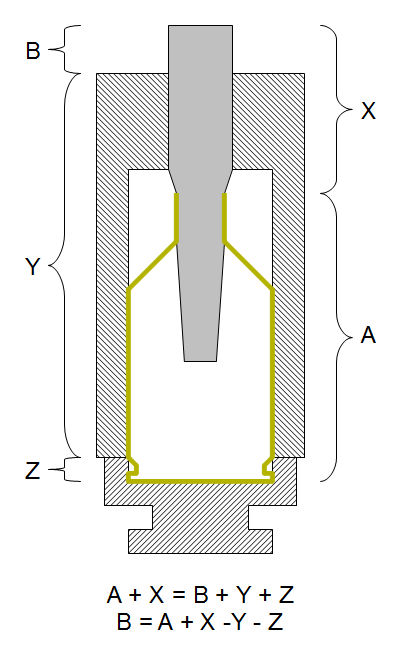Forming .358 WSSM Cases
The .358 WSSM is a wildcat cartridge made by necking up a WSSM (Winchester Super Short Magnum) case up to accept a .358" diameter bullet. This cartridge is primarily popular in Indiana, due to caliber restrictions in place for hunting whitetail deer in that state.
The basic steps are as follows:
- Anneal
- Expand to .30
- Anneal
- Expand to .35
- Anneal
- Turn Necks
- Size & Trim
Case Selection
I form cases for this cartridge from Winchester .25 WSSM brass. It is (currently) readily available. It also seems to have thick material at the neck. Since the neck gets thinner when we expand, this means we will have still have enough thickness after expanding.
I have been told that Federal .243 WSSM cases are superior for forming into this caliber. However, Federal is no longer making ammunition or cases in this caliber.
Annealing
The purpose of annealing is to soften the brass. Brass that is too hard and brittle will split when you try to expand the necks. Working the brass makes it harder, and that includes the act of expanding the neck. We need to anneal the brass to make it soft enough to expand without splitting, and we need to anneal the brass again after we have expanded it so that it has a useful case life after we have formed it. We have also found that we get fewer split necks during the forming process if we anneal the cases after expanding halfway. That's three annealing steps.
There are lots of resources out there explaining how to anneal brass, and there is some disagreement. I won't bother to explain the process here.
However, one thing I can tell you is that it is important for the cases to be rotating while you heat them. If not, one side will be longer and thinner after expanding. The uneven length is not terribly important, but the uneven neck thickness will lead to accuracy problems. Neck turning may not be able to fully correct the problem. I place my cases into a 14mm deep socket with a couple of washers wedged into the bottom to control the height. I chuck this up in my drill, and it rotates the case for me while I hold it in the flame.
Expanding
To expand the necks, I use a CH-4D expander die with two different expander plugs. The 2.5" expander die body is the appropriate size for the WSSM case. I have two tapered expander plugs: one expands from .255" to .300", and the other expands from .300" to .358".
I need to be careful to properly adjust the first (smaller) expander plug to the correct depth, since its shank is larger than the target diameter. It will over-expand the neck if I adjust it too deep. For my setup, I need to adjust the plug to protrude .986" above the die body. The diagram below explains this.
Be sure to lubricate the inside of the neck before sizing. Imperial Sizing Wax is ideal for this.

Neck Turning
Neck turning is the removal of material from the outside of the neck. The purpose of this is to make the neck thickness uniform – from one side of the neck to the other, and from one case to the next. If the neck thickness is uneven, the bullet will be incorrectly aligned and accuracy problems will be introduced. This cannot be corrected by fire forming. The potential for necks to expand unevenly is high, especially if the necks are not annealed consistently.
Unfortunately, the better quality neck turning tools are not able to handle the .358" diameter. I need to select a tool.
- Sinclair Driver-style Caseholder, 05240
- Sinclair Large Caliber Neck Turning Tool, NT-5000
- Sinclair Large Caliber Turning Mandrel, NTA35
You also want to own a micrometer. A standard caliper is not precise enough for this measurement. This job requires a tool that can measure with .0001" accuracy.
You will need to know the neck diameter of your rifle's chamber; hopefully your gunsmith has provided this information. You generally want .001" of free space around the neck, so the diameter of a loaded neck should be .002" smaller than the chamber diameter. My chamber's neck is .393", so my target diameter is .391", which will give me a neck thickness of .0165".
There will be some trial and error in setting up the cutter, even if there are cutting depth markings on the turning tool. It is important to measure the outside neck diameter with a bullet loaded in the neck. This is the only way to accurately measure the diameter.